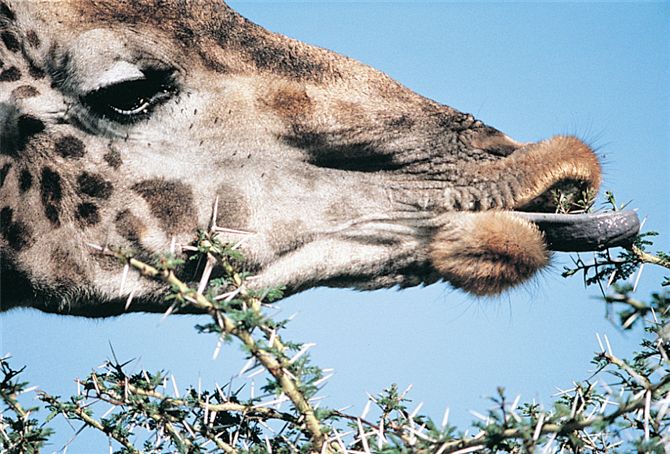 |
| Previous Image | Next Image |
| Description: Although morphological defences are widespread among plants, plants also contain a variety of chemical defences that can be roughly divided as (1) toxins, and (2) digestion-reducing substances. Toxins are chemicals that kill, impair, or repel most would-be herbivores. The compounds are widely used by humans as medicines, and include such compounds as cocaine, morphine, digitalis, and others. Digestion-reducing substances are generally phenolic compounds, such as tannins, that bind to plant proteins and inhibit their breakdown by digestive enzymes. This in turn further reduces the value of plants as food for the herbivore. Humans are familiar with tannins as the bitter taste one gets when eating an unripe banana, or as the dark colouration in a cup of Earl Grey tea. Chemists have isolated thousands of toxins from plant tissues, and the list continues to grow. The great variety of plant toxins defies easy description and generalization. However, one interesting pattern is that more tropical plants contain toxic alkaloids than their temperate counterparts. Despite these higher levels of chemical defence, herbivores appear to remove approximately 11%–48% of leaf biomass in tropical forests, while only about 7% in temperate forests. These higher levels of herbivore attack on tropical plants suggest that natural selection for chemical defence is more intense in tropical plant populations. However, clearly no defence is perfect. Plant chemical defences often work against some herbivores, but not all. The tobacco plant uses nicotine, a toxic alkaloid, to repel herbivorous insects, most of which die immediately upon ingestion. However, several insects specialize in eating tobacco plants and manage to avoid the toxic effects of nicotine. Unfortunately, humans do not fall into this group of specialist insects and thus the health consequences of regular ingestion of this toxic plant are readily apparent. Some of the specialist insects avoid such harm by excreting nicotine, while others convert it to nontoxic molecules. Similarly, toxins and repellents produced by plants in the cucumber family repel most herbivorous insects but attract the spotted cucumber beetle. This beetle is a specialist that feeds mainly on members of the cucumber family. Some specialized herbivores go even further by using plant toxins as a source of nutrition. Even more amazing is that some species, such as the Monarch butterfly and the dogbane leaf beetle, are able to sequester plant toxins, using these as chemical deterrents against their own natural enemies, such as predators. As we have seen with competition and foraging, plants are able to alter their physiology and morphology in response to changes in their environment, such as the deposition of a nutrient patch or the presence of a competitor. Plants show similar plasticity in response to herbivores. Many morphological and chemical defences are constitutive defences, produced continuously, independent of what happens to a plant. Many, however, are also induced defences, where concentrations of defensive chemicals (or even morphological defenses) increase rapidly in response to the first indication of herbivore damage. Such induced defences make sense in the context of the theory of allocation, where allocating energy and limited resources to defences when insects are not around seems maladaptive. It seems likely that the benefit of producing constitutive or induced defences will depend upon the likelihood of a plant being attacked. The world may appear green to us, but to herbivores only some shades of green are edible. Plant defences and the adaptations of herbivores that overcome those defences are complex.
Picture Stats: Views: 2706 Filesize: 86.9kB Height: 454 Width: 670 Source: https://biology-forums.com/index.php?action=gallery;sa=view;id=1960 |
